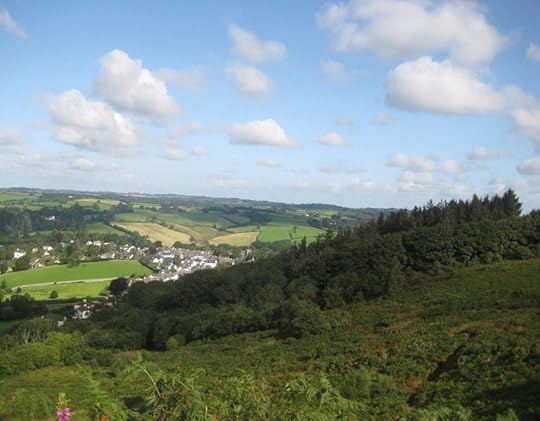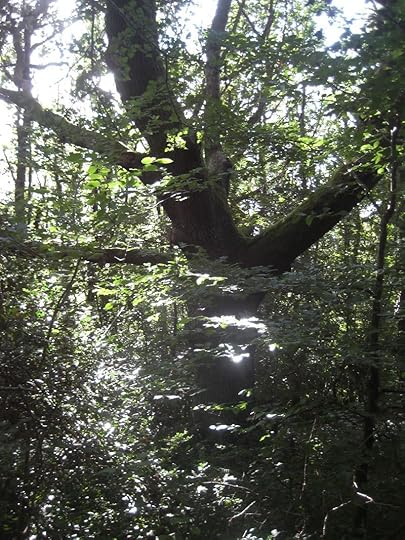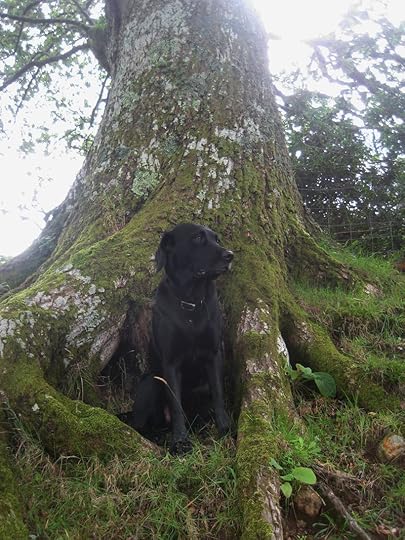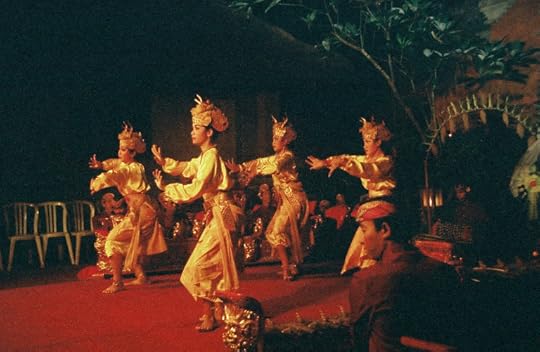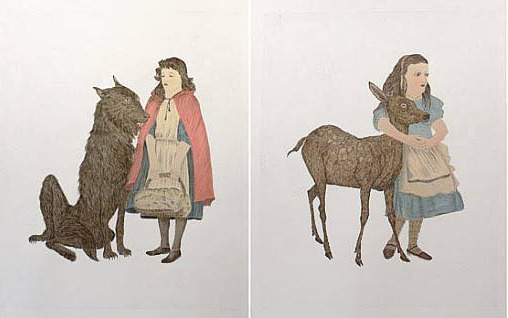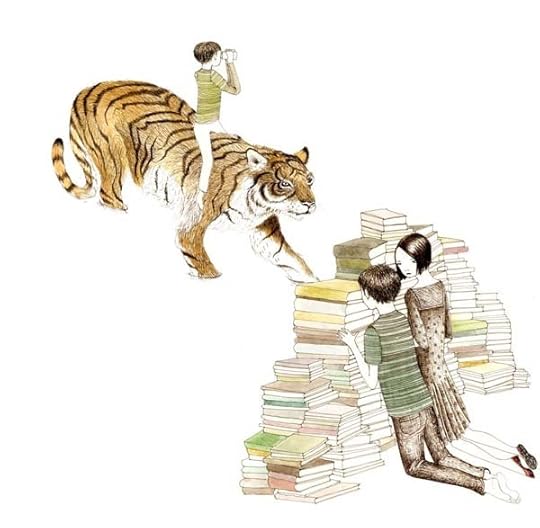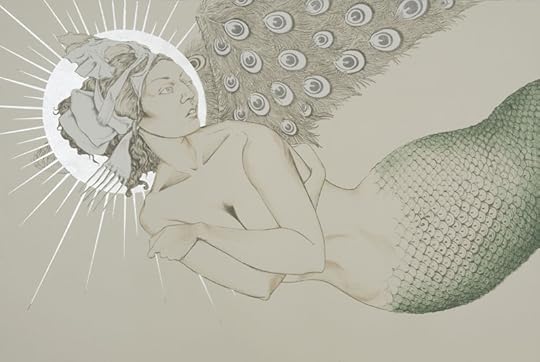Terri Windling's Blog, page 212
September 6, 2012
The Coyote Clan
From An Unspoken Hunger by Terry Tempest Williams:
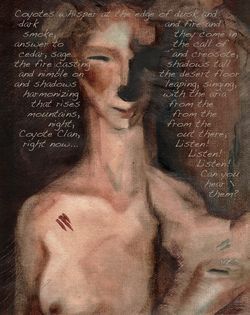
"Members of the Coyote Clan are not easily identified, but there are clues. You can see it in their eyes. They are joyful and they are fierce. They can cry louder and laugh harder than anyone on the planet. And they have an enormous range.
"The Coyote Clan is a raucous bunch: they have drunk from desert potholes and belched forth toads. 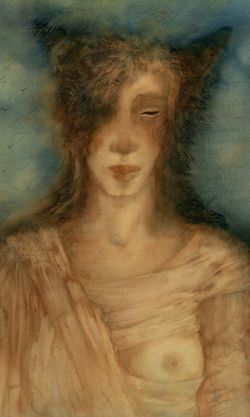 They tell stories with such virtuosity that you'll swear you've been in the presence of preachers.
They tell stories with such virtuosity that you'll swear you've been in the presence of preachers.
"The Coyote Clan is also serene. They can float on their backs down the length of any river or lose entire afternoons to the contemplation of stone.
"Members of the Clan court risk and will dance on slickrock as flash floods erode the ground beneath their feet. It doesn't matter. They understand the earth re-creates itself day after day."
Their range is wide indeed...all the way to the green hills of Devon, and far beyond. Here in the Mythic Arts field, I like to think there's a little coyote in us all.
 Paintings above: "Coyote and the Dog Spirits," "The Coyote Clan," and "Coyote Woman." Photograph: "Howling Away at the Gray" by Shreve Stockton, from her wonderful Daily Coyote site. I also highly, highly recommend her book of the same title. More coyote reading: articles here and here; poetry here, here, and here.
Paintings above: "Coyote and the Dog Spirits," "The Coyote Clan," and "Coyote Woman." Photograph: "Howling Away at the Gray" by Shreve Stockton, from her wonderful Daily Coyote site. I also highly, highly recommend her book of the same title. More coyote reading: articles here and here; poetry here, here, and here.
September 5, 2012
Bearing Witness
From "An Interview with Terry Tempest Williams" by Jana Bouck Remy in Irreantum (2002):
"I do not write every day," says Williams. "I write to the questions and issues before me. I write to deadlines. I write out of my passions. And I write to make peace with my own contradictory nature. For me, writing is a spiritual practice. A small bowl of water sits on my desk, a reminder that even if nothing is happening on the page, something is happening in the room--evaporation. And I always light a candle when I begin to write, a reminder that I have now entered another realm, call it the realm of the Spirit. I am mindful that when one writes, one leaves this world and enters another.
"My books are collages made from journals, research, and personal
experience. I love the images rendered in journal entries, the immediacy
that is captured on the page, the handwritten notes. I love the depth
of ideas and perspective that research brings to a story, be it
biological or anthropological studies or the insights brought to the
page by the scholarly work of art historians.

"When I go into a library, I
feel like I am a sleuth looking to solve a mystery. I am completely
inspired by the pursuit of knowledge through various references. I read
newpapers voraciously. I love what newspapers say about contemporary
culture. And then you go back to your own perceptions, your own words,
and weigh them against all you have brought together. I am interested in
the kaleidoscope of ideas, how you bring many strands of thought into a
book and weave them together as one piece of coherent fabric, while at
the same time trying to create beautiful language in the service of the
story. This is the blood work of the writer.
"Writing is also about a life engaged. And so, for me, community
work, working in the schools or with grassroots conservation
organizations is another critical component of my life as a writer. I
cannot separate the writing life from a spiritual life, from a life as a
teacher or activist or my life intertwined with family and the
responsibilities we carry within our own homes. Writing is daring to
feel what nurtures and breaks our hearts. Bearing witness is its own
form of advocacy. It is a dance with pain and beauty."
From an interview with Terry Tempest Williams by Derrick Jensen in Listening to the Land: Conversations about Nature, Culture, and Eros:
"I've been thinking about what it means to bear witness. The past ten
years I've been bearing witness to death, bearing witness to women I
love, and bearing witness to the [nuclear] testing going on in the
Nevada desert. I've been bearing witness to bombing runs on the edge of
the Cabeza Prieta Wildlife Refuge, bearing witness to the burning of yew
trees and their healing secrets in slash piles in the Pacific Northwest
and thinking this is not so unlike the burning of witches, who also
held knowledge of heading within their bones. I've been bearing witness
to traplines of coyotes being poisoned by the Animal Damage Control. And
I've been bearing witness to beauty, beauty that strikes a chord so
deep you can't stop the tears from flowing. At places as astonishing as
Mono Lake, where I've stood knee-deep in salt-water to watch the fresh
water of Lee Vining Creek flow over the top like water on
vinegar....It's the space of angels. I've been bearing witness to
dancing grouse on their leks up at Malheur in Oregon.
"Bearing witness to
both the beauty and pain of our world is a task that I want to be part
of. As a writer, this is my work. By bearing witness, the story that is
told can provide a healing ground. Through the art of language, the art
of story, alchemy can occur. And if we choose to turn our backs, we've
walked away from what it means to be human."
September 4, 2012
An Unspoken Hunger
From "The Politics of Place," an interview with Terry Tempest Williams conducted by Scott London (on the Insight & Outlook radio show):
London: You've said that your connection to the natural world is also your connection to yourself. Do you think that's true for everybody?
Williams: We're animals. I think we forget that. I think there is an ancient archetypal memory that still exists within us. If we deny that, what is the cost? So I do think it's what binds us as human beings. I wonder, what is it to be human? Especially now that we're so urban. How do we remember our connection with place? What is the umbilical cord that roots us to that primal, instinctive, erotic place? Every time I walk to the edge of this continent and feel the sand beneath my feet, feel the seafoam move up my body, I think, Ah, yes, evolution. You know, it's there, we just forget....
...I worry that we we are a people in a process of great transition and we are forgetting what we are connected to. We are losing our frame of reference. Pelicans pass by and we hardly know who they are, we don't know their stories. Again, at what price?
I think it's leading us to a place of inconsolable loneliness. It's what I mean by "an unspoken hunger." It's a hunger than cannot be quelled by material things. It's a hunger that cannot be quelled by constant denial. I think that the only thing that can bring us into a place of fullness is being out in the land with other.
Then we remember where the source of our power lies.
The full interview can be read in A Voice in the Wilderness: Conversations with Terry Tempest Williams, edited by Michael Austin (USU Press, 2006).
September 3, 2012
When Women Were Birds
I've recently read Terry Tempest Williams' new book, When Women Were Birds: Fifty-four Variations on Voice, and I'm completely under its spell. It's a beautiful meditation on land, love, family, faith, activism, and art...all rooted in the red rock of southern Utah; a book that I already known I'll return to often in the years ahead.
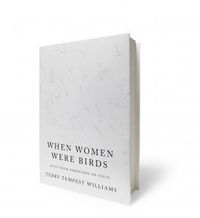 When it ended, I found myself so unwilling to part with William's clear, honest voice in my ear that I pulled out a stack of her previous books: Refuge, Red, Leap, etc.. They are wonderful to re-read all at once, in the sequence of publication, which allows one to follow the evolution of her work, politics, and spiritual beliefs. And although I first read these volumes when I, too, lived in the American South-west, returning to her books from the green hills of Devon underscores how universal our need is for connection to the wild.
When it ended, I found myself so unwilling to part with William's clear, honest voice in my ear that I pulled out a stack of her previous books: Refuge, Red, Leap, etc.. They are wonderful to re-read all at once, in the sequence of publication, which allows one to follow the evolution of her work, politics, and spiritual beliefs. And although I first read these volumes when I, too, lived in the American South-west, returning to her books from the green hills of Devon underscores how universal our need is for connection to the wild.
So this, dear readers, is "Terry Tempest Williams Week" here at The Drawing Board, with a week's worth of quotes drawn from various books, essays, and interviews. Today's quote is from When Women Were Birds -- excerpted from a passage in which Williams reflects on the powerful art installation pictured below. (The birds are made out of X-ray film from hospital MRIs.)
"Now, in a shift of light," Williams writes, "the shadows of birds are more pronounced
on the gallery's white wall. The shadow of each bird is speaking to me.
Each shadow doubles the velocity, ferocity of forms. The shadow, my
shadow now merges with theirs. Descension. Ascension. The velocity of
wings creates the whisper to awaken....
"I want to feel both the beauty and the pain of the age we are living
in. I want to survive my life without becoming numb. I want to speak and
comprehend words of wounding without having these words become the
landscape where I dwell. I want to possess a light touch that can
elevate darkness to the realm of stars."
Yes. Yes. Yes.
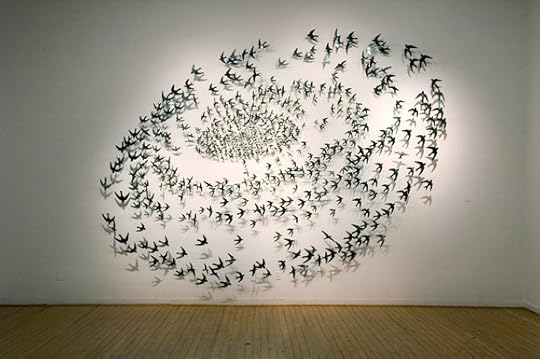 "Swoop" by Julia Barello. Please visit the artist's website to see more of her work. If you're in the mood for further reading, an old article on mine on the folklore of birds is here.
"Swoop" by Julia Barello. Please visit the artist's website to see more of her work. If you're in the mood for further reading, an old article on mine on the folklore of birds is here.
September 2, 2012
Tunes for a Monday Morning
Both tunes today are by singer/songwriter Jeremy Messersmith, from the Twin Cities in Minnesota, with animation by Eric Power. Messersmith has three albums out to date, all available on his website as pay-whatever-you-want downloads.
Above: "A Girl, a Boy, and a Graveyard." (A live performance of the song is here.)
Below: "Organ Donor." Both tunes are from the most recent CD, The Reluctant Graveyard.
August 23, 2012
Holding on to what's good
"One of the things we continue to learn from Native Peoples is that stories are our medicine bundles. I feel that way about our poems, our essays, our fictions. That it is the artist who carries the burden of the storyteller. Terrence Des Pres speaks of 'a prose witness' that relies on the imagination to arrive at the heart of the matter. I believe this is our task as writers to respond to the world as we see it, feel it, and dare to ask questions that will not allow us to sleep. Imagination. Attention to details. Making the connections. 'Art -- right word to station the mind and hold the heart ready.' " - Terry Tempest Williams
“Hold on to what is good even it is a handful of earth. Hold on to what
you believe even if it is a tree which stands by itself. Hold on to what
you must do even if it is a long way from here. Hold on to my hand,
even when I have gone away from you.” - Nancy Wood
I'll be off-line all of next week, and then back in the office (and back
to this blog) on Monday, September 3rd. Have a good week, everyone.
Art above: Oak tree drawing by John Constable (1776-1837)
August 22, 2012
Holding the World in Balance
From an interview with Chickesaw writer Linda Hogan:
"There is the story that so many tell of the time when humans and animals could change into each other. There were times when animals and people spoke the same language, or when the animals helped the humans. For instance, our mythology says it was the spider who brought us fire.
"I’ve thought about these human-animal relationships for years – is this true? Well, humans and animals existed together for many thousands of years without creating the loss of species. There was enormous respect given to animals. I have to trust the knowledge of indigenous people because it held a world in balance.
"I have a special interest in ceremonies. I look at a ceremony called The Deer Dance. In the ceremony, I watch the entire world unfold through the life of the deer and a man dressed as a deer. The man dances all night. It is as if he were transformed into a deer. This is a renewal ceremony for the people. The deer that lives in the mountains far from the people provides them with life.
"The purpose of most ceremonies – such as healing ceremonies – is to return one person or group of people to themselves, to place the human in proper relationship with the rest of the world. I thought that we were out of touch with ourselves 20 years ago. Now, with computers and email and cell phones, we are even more out of touch. How many of us even stay in touch with our own bodies? If we aren’t inhabiting our own bodies, how can we understand animal bodies of the world?"
(I recommend reading the full interview here.)
Images above: "The Mule Deer Child," Yaqui and Mayo deer dancers (photographed during public dance displays, not sacred ceremonies), a deer dancer in Bhutan, a women's deer dance in Bali, a Tibetan Cham Deer; a deer dance by performer and installation artist Carolyn Ryder Cooley; and performers from the Tucson "circus and fire theatre" troupe Flam Chen. Further reading: "Deer Woman and the Living Myth of the Dreamtime" by Carolyn Dunn, "Where the White Stag Runs" by Ari Berk, and "Balance of the World, Parts I and II" by Howard Gayton.
August 21, 2012
Shape-shifting
From the Introduction to The Beastly Bride: Tales of the Animal People, a YA anthology I edited with Ellen Datlow:
"Contemporary writers use animal-transformation themes to explore issues of gender, sexuality, race, culture, and the process of transformation...just as storytellers have done, all over the world, for many centuries past. One distinct change marks modern retellings, however, reflecting our changed relationship to animals and nature. In a society in which most of us will never encounter true danger in the woods, the big white bear who comes knocking at the door [in fairy tales] is not such a frightening prospective husband now; instead, he's exotic, almost appealing.
"Whereas once wilderness was threatening to civilization, now it's been tamed and cultivated; the dangers of the animal world have a nostalgic quality, removed as they are from our daily existence. This removal gives "the wild" a different kind of power; it's something we long for rather than fear. The shape-shifter, the were-creature, the stag-headed god from the heart of the woods--they come from a place we'd almost forgotten: the untracked forests of the past; the primeval forests of the mythic imagination; the forests of our childhood fantasies: untouched, unspoiled, limitless.
"Likewise, tales of Animal Brides and Bridegrooms are steeped in an ancient magic and yet powerfully relevant to our lives today. They remind us of the wild within us...and also within our lovers and spouses, the part of them we can never quite know. They represent the Others who live beside us--cat and mouse and coyote and owl--and the Others who live only in the dreams and nightmares of our imaginations. For thousands of years, their tales have emerged from the place where we draw the boundary lines between animals and human beings, the natural world and civilization, women and men, magic and illustion, fiction and the lives we live."
Images above: "Perched" by Kelly Louise Judd (Kansas City), two prints by Kiki Smith (New York), "Book and Tiger" by Julie Morstad (Vancouver), "Beauty and the Beast" by William Heath Robinson (English illustrator, 1872-1913), and "Bitch" by Kay Fu (Brooklyn). Please follow the links to see more of their work. Further reading: "Into the Woods: On British Forests, Myth and Now" by Ruth Padel.
August 20, 2012
Crossing over
A passage from Brenda Peterson's Build Me an Ark: A Life with Animals, in which she is swimming with a dolphin pod on the Florida coast:
"'Crossover' is a word scientists use to describe dolphins' soaring over seas, their traveling so free and fast, so high-spirited and almost effervescent that their sleek bodies barely skim the waves. The suggestion of splashes from tail and pectoral leaves a luminous wake across the water. For these crossover miles, the dolphins, like their human terrestrial mammal kin, belong more to the element of air than the sea....
"Held in [the dolphins'] fluid embrace, I pulled my arms close against my sides and our communal speed increased... Racing around the lagoon, I opened my eyes again to see nothing but an emerald underwater blur. And then I remembered what I had either forgotten long ago or never quite fully realized. This feeling of being carried along by other animals was familiar.
"Animals had carried me all my life. I was a crossover--carried along in the generous and instructive slipstream of other species. And I had always navigated my life with them in mind, going between the human and animal worlds--a crossover myself. By including animals in my life I was always engaging with the Other, imagining the animal mind and life. For almost half a century, my bond with animals had shaped my character and revealed the world to me. At every turning point in my life an animal had mirrored or influenced my fate. Mine was not simply a life with other animals, but a life because of animals.

"It had been this way since my beginning, born on a forest lookout station in the High Sierras, surrounded by millions of acres of wilderness and many more animals than humans. Since infancy, the first faces I imprinted, the first faces I ever really loved, were animal."
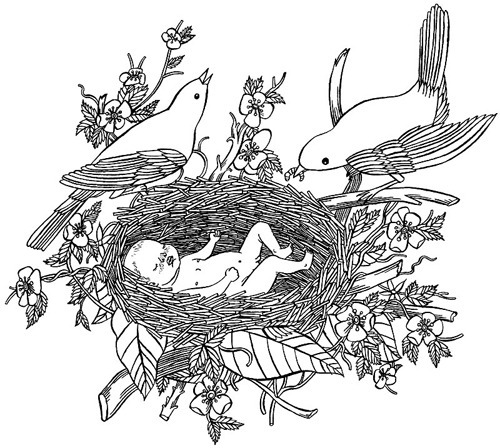
If you haven't yet read Brenda's luminous work (which includes fiction, essays, memoirs, and anthologies), please do seek it out. The link above goes to her website, and her blog (on books, nature, seal watching and more) is here.
Images above: "Mermaid in Flight" by Fay Ku (Brooklyn), "Sky Pack" by Julianna Swaney (Portland), "Fox Confessor" by Julie Morstad (Vancouver), and "Hank" by Carson Ellis (Portland). Please visit their websites to see more of their art.
August 19, 2012
Tunes for a Monday Morning
Following on from Friday's post, today's tunes are all inspired by the sea.
First:
Caorolyn Allan and Jenny Keldie sing the old Scottish ballad "The Great Selkie of Sule Skerry," and explain it's meaning to Phil Cunningham. The beautiful video comes from Scotland's Music, with Phil Cunningham, produced for the BBC.
Next:
"Rockpool," a song from the lovely Martha Tilston in Cornwall, off her Lucy and the Wolves cd.
And last:
"The Old Ways," from the great Canadian singer/songwriter and music scholar Loreena McKennitt, off her Nights in the Alahambra dvd. (A longer post on McKennitt is here.)
 Images above: "The Tempest: Miranda" by John W. Waterhouse (1849-1917), Tilly on the Cornish coast, and "Small craft Warning" by Jeanie Tomanek.
Images above: "The Tempest: Miranda" by John W. Waterhouse (1849-1917), Tilly on the Cornish coast, and "Small craft Warning" by Jeanie Tomanek.
Terri Windling's Blog
- Terri Windling's profile
- 708 followers








